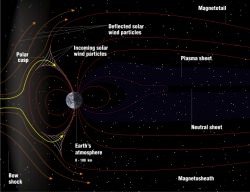There’s the Earth, and the Moon, separated by 385,000 or so kilometres. Once the astronauts return to the Moon, they’ll lose all the protection of the Earth’s atmosphere and magnetic field – getting blasted by radiation and cosmic rays. Or will they? According to researchers from the University of Washington, there are times when the Earth does help shield the Moon.
One of the major risks of space travel are solar storms. These are flurries of particles blasted off the Sun at nearly the speed of light. They can arrive with almost no notice. As soon as an Earth-directed flare is seen on the surface of the Sun, the particles will arrive just minutes afterwards.
To avoid a potentially lethal blast of radiation, the astronauts will need to seek cover in a shielded base, or at least make sure there’s a mass of lunar soil between them and the oncoming storm. When they’ve only got a few minutes warning, the astronauts will be restricted to how far they can explore on the lunar surface.
Here on Earth, we’re protected by the magnetosphere, which directs the solar wind harmlessly around the planet. Astronomers have known for many years that the Moon passes through the Earth’s magnetic sphere, and could share in our protective shield.
Researchers from the University of Washington have developed computer models of the Earth’s magnetosphere, calculating the ideal times when astronauts will receive the most protection from solar storms.
There’s an additional problem with solar storms. As the particles interact with the Earth, they heat up oxygen in the ionosphere. These particles stream away from the Earth and collide with the Moon. These are moving less quickly than the solar wind particles, but they can still add to an astronaut’s radiation exposure.
Original Source: UW News Release


I agree there must be protection times.
I assume these must be at times of Full Moon when the Earth is directly between the Sun and the Moon? The Moon would then be in the deformed magnetosphere.
Brian
Bugger.
Looks like space tourism could be in for another hiccup.
Seriously, I assume as the energised oxygen particles in the last paragraph move more slowly, would the astronauts get more warning, even given the closer proximity of the earth to the moon?